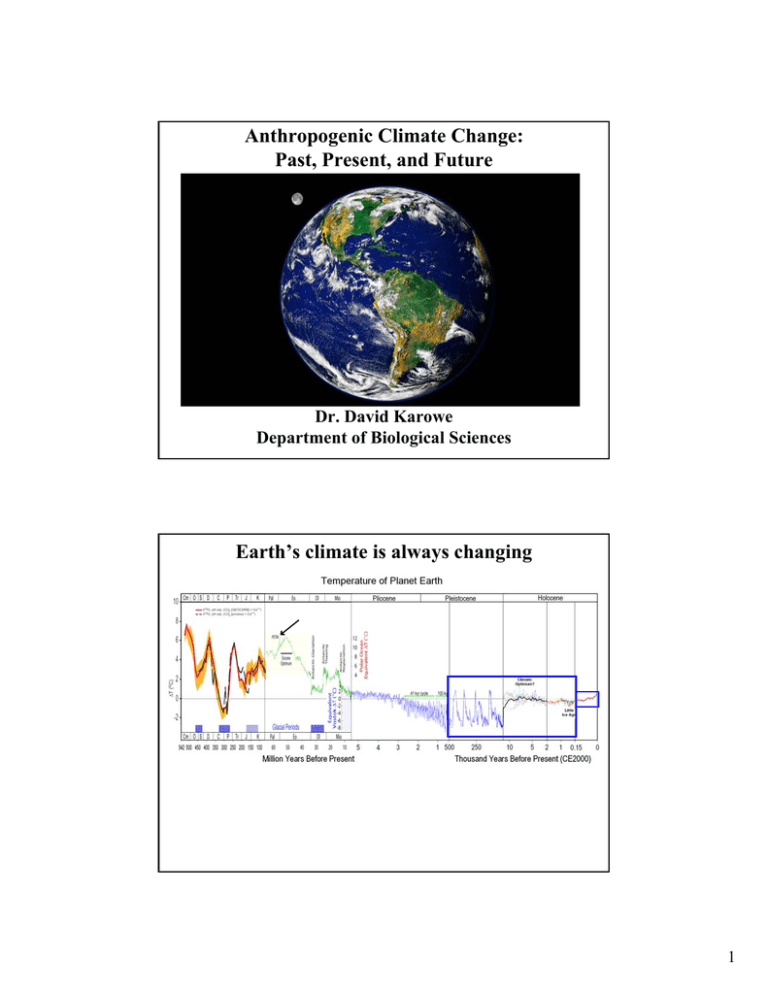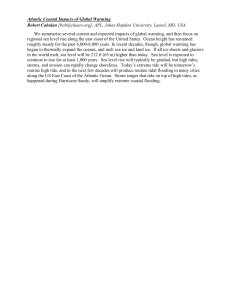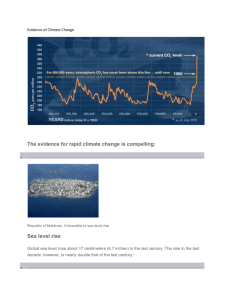Anthropogenic Climate Change: Past, Present, and Future Earth’s climate is always changing
advertisement

Anthropogenic Climate Change: Past, Present, and Future Dr. David Karowe Department of Biological Sciences Earth’s climate is always changing 1 Antarctic ice cores provide a record of Earth’s climate over the past 800,000 years - air bubbles trapped in ice reveal past CO2 levels Over the past 800,000 years, Earth has experienced repeated ~100,000 yr climate cycles - greenhouse gasses have co-varied with temperature 2 Pleistocene climate cycles are due to Milankovitch Cycles Last Glacial Maximum was about 18,000 years ago - global temperature was only about 5o C cooler than today 3 and sea level was about 350 feet lower Tree ring and thermometer records indicate two anomalous periods since 500 AD modern warming Little Ice Age 4 Video included here see 18,000 bp – present at http://homepages.wmich.edu/~karowe/Teaching%202010.html Animation: North America 19,000 BC to 3,000 AD “Little Ice Age” from ~1500-1800 AD - global temperature was ~ 1o C cooler than today - most of Europe was noticeably cooler 5 Little Ice Age was due to decreased solar activity during the Maunder Minimum Tree ring and thermometer records indicate two anomalous periods since 500 AD modern warming Little Ice Age 6 Climate change since the Industrial Revolution Since 1900, Earth has warmed ~ 0.8o C 12 warmest years in history: 2002-2012, 1998* Warmest year: 2010 - warming is now 20x faster than any time in ice cores 7 Temperature difference relative to 1950-1980 video available at http://data.giss.nasa.gov/gistemp/animations/ Precipitation is a very important component of climate - severe rainstorms have become more common - 20% increase in Michigan since 1948 - 50% increase in southwest Michigan 8 Flooding has increased globally in the last 50 years ex ce ex ptio tre na se me l v m ere od e m rat ild e dr ou gh 2000-2009 t Much of the world is also already experiencing more frequent and stronger droughts 1950-1959 Palmer Drought Severity Index (PDSI) 9 Arctic summer sea ice has been decreasing rapidly August 27, 2012 - record low in 2012 Greenland ice sheets is melting at an accelerating rate 2012 - meltwater lubricates underside of ice sheet 10 Major climate predictions are already coming true in the U.S. - in 2011, 10 states had their wettest spring on record As a result, there was extensive flooding 11 2012 was the warmest year on record for 19 states - and for the entire contiguous U.S. This year, severe drought covered much of the U.S. December 2012 74% drought 12 Can climate change be due to “natural variation”? - three lines of evidence argue that current climate change is NOT due to natural factors 1. Since 1900, heat added by greenhouse gasses is about 20 times heat added by the sun heat added by greenhouse gasses heat added by the sun 13 Solar Irradiance 2. While Earth has been warming fastest, energy from the sun has decreased 3. Models do a good job of replicating past climate change only if they include anthropogenic factors anthropogenic and natural factors modeled natural factors only observed - natural factors would have caused a slight cooling since 1900 14 In two major ways, current warming is very different than any warming period in at least the last 800,000 years 1. It’s at least 20 times faster 2. It’s happening while solar input is decreasing But, since climate has changed before, it must be changing now for the same reason, right? Would the same reasoning apply to recent increases in forest fires and lung cancer? Best estimate: at least 95% of current warming is due to human activities Greenhouse gas emissions Deforestation 15 What does the future hold? It depends on the choices we make Depending on our actions, Earth is likely to warm by at least 2-4o C by 2100 “Business as usual” 4o 2o 0.6o Alternate energy sources Zero emissions 16 Will a 4o temperature rise matter? When Earth was 5o cooler: Arctic is likely to warm at about twice the global rate e.g. with 3.5o C average global warming by 2100: - Arctic is site of strongest positive feedbacks 17 Arctic summer sea ice expected to disappear by 2070 For the video include here, see present – 1,000 years into the future at: http://homepages.wmich.edu/~karowe/Teaching%202010.html Animation: North America 19,000 BC to 3,000 AD Many glaciers are likely to disappear by 2100, including all intertropical glaciers by 2030 - 750,000,000 people in China and India rely on glaciers and seasonal snowpacks for their water supply 18 Continued loss of ice sheets - full melting of Greenland ice sheet → 7 m sea level rise - full melting of Antarctic ice sheet → 57 m sea level rise Sea level is expected to rise by 1-2 meters by 2100 - 10 million to 300 million people could be flooded each year with 1 meter rise 19 Much of U.S. would be affected by 1 meter rise Increase in inland flooding due to severe rainfall 20 Decrease in summer rainfall throughout the U.S. ex ce ex ptio tre na se me l v m ere od e m rat ild e dr ou gh 2060-2069 t Much of the world is likely to experience much more frequent and stronger droughts by the 2060s Palmer Drought Severity Index (PDSI) - current drought indices may no longer work properly 21 Michigan will experience many more days over 90o F Most summers are likely to be hotter than any experienced thus far 22 Many areas are also predicted to experience “disappearing climates” by 2100 Low Moderate High Probability of disappearing climate Bottom Line: 1. We’re causing climate to change at an alarming rate 2. If we continue on our current path, the future is very likely to include unprecedented hardships for all of Earth’s species, including humans 3. Many of the worst scenarios can be avoided by choices we have available today 23


